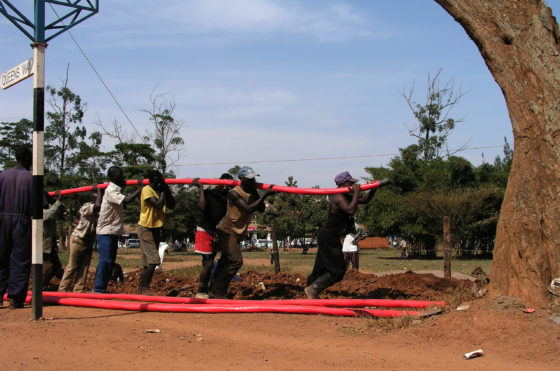
Corruption in construction
The construction industry is the backbone of economic growth in many developing countries. Given the magnitude of funds that are funneled annually into infrastructure projects, scope for corruption and profiteering are high. Governments need greater tools to audit and monitor public spending and better manage public-private partnerships in the construction industry.
Corruption, defined as the abuse of power for private gain, comes in various forms.This includes embezzlement, bribery, nepotism, influence peddling, theft of public funds or assets, fraud, forgery, causing financial or property loss, false accounting in public affairs and tax evasion. In developing countries, corruption is considered to be one of the most severe frictions impeding economic growth. In fact, the OECD estimates that on an annual basis, approximately 150 million USD is lost through corrupt and inefficient practices in Africa alone.
 Workers in Kampala, Uganda. Photo: Arne Hoel / World Bank
Workers in Kampala, Uganda. Photo: Arne Hoel / World Bank
Photo ID: Hoel_030312_P3121132
Policies aimed at reallocating resources away from corrupt agents will be instrumental in improving the overall efficiency in the economy and thus a fundamental aspect of growth policy. To date, there is little systematic evidence on what works and what does not with regards to anti-corruption policies. Successful interventions have to understand and be modeled around the incentives of individual agents and these will also change given the overall environments within which they operate. Therefore, evidence that these interventions are indeed working, by correctly responding to the evolving incentives of individual actors, is essential.
The construction industry
At the center of these debates on corruption is the construction industry, which accounts for about one-third of gross capital formation. This is a particularly significant industry for developing countries as it provides the foundation for infrastructure development. This is, in turn, arguably the backbone for economic growth. You cannot promote education without the construction of schools, provide quality clinical services without hospitals or develop markets without sufficient road access, to name a few examples. However, there is also a lot of money in infrastructure development. According to estimates from CoST International, global construction output is expected to grow to approximately $17.5 trillion annually by the year 2030. At the same time, if losses in this industry persist, which are currently estimated to amount to 10-30 per cent, then by 2030 over $6 trillion will be lost across the world in the process.
There are various reasons why corruption is so pervasive in the construction sector. In particular, the size and therefore volume of funds flowing through these projects make it easier to inflate prices. For example, the construction of a railway line can cost upwards of billions of dollars and thus it becomes easier to add extra money to the total funds, for bribes and kick-backs, without it being immediately obvious. Furthermore, it is often difficult to accurately assess the quality of the final project until long after the contract has been paid out. This is especially visible in the road sector, where sub-standard construction can lead to the appearance of potholes and other damages only after the road has been completed.
A further reason for the presence of corruption in this sector may be the result of the bureaucracy involved in the procurement processes. Due to the volume of investment required for infrastructure projects, it is usually the public sector which contracts out jobs to the private sector. In this respect, governments play the role of both clients and regulators. However, in some cases they may even be the owners of construction companies themselves. While regulation of the sector is therefore extremely necessary, it is difficult and often quite a nebulous, poorly enforced process.
Auditing the construction sector
To overcome these shortcomings in the regulatory environment, the key is to increase transparency. One of the most common tools used by governments to monitor public goods expenditures are randomised audits of public funds. In an environment with high levels of asymmetric information and imperfect contract enforcement, regular monitoring and other similar transparency initiatives can prove valuable to both private and public sector firms. Therefore, understanding the impact these audits can have on the private sector has potentially significant policy implications for economic growth.
Corruption and inefficiency in public procurement are an outcome of the interaction between public and private sector parties, and this duality should be taken into account when designing and enforcing monitoring mechanisms. To date, most government and procurement audits aim to discipline inefficient public bodies and too much emphasis is placed on the audit itself, rather than the necessary steps needed to make the information accessible. A more integrated approach, where private sector participants are held accountable directly can therefore be beneficial. Moreover, the effectiveness of government audits also depends on the delivery mechanism used to spread the information contained in these audits. Making the outcomes of these audits available to the public and other relevant stakeholders will make both firms and public officials more accountable and thus lead to a more competitive environment as a result of the increased transparency.

